Walking the path at night, I hear near-constant rustling in the dried leaves. All along the route from my cottage to the shower block, I hear creatures scurrying away. Crabs. More crabs than I ever imagined possible.
I’m at Palmyra Atoll, a remote island 1,000 miles south of Hawai’i, to participate in a fish research trip. Palmyra is a very crabby place. There are 12 species of land crab here, and their populations have been growing since the removal of invasive rats.
Crabs also feature prominently in any Palmyra stay. Soon after landing on Palmyra, all researchers and visitors must attend an orientation to review safety rules. The remote island, administered by The Nature Conservancy and U.S. Fish and Wildlife Service, has no permanent inhabitants, so following rules and protocols is paramount. And one of the first rules you learn is a simple one: Watch your step. Watch every step.
This is in part for your safety; Palmyra is very, very far from medical assistance. But it’s also for the crabs. In the evenings, hermit crabs and other species come out en masse. You must use a headlamp and you have to walk carefully, as the path is like a crustacean-themed obstacle course.
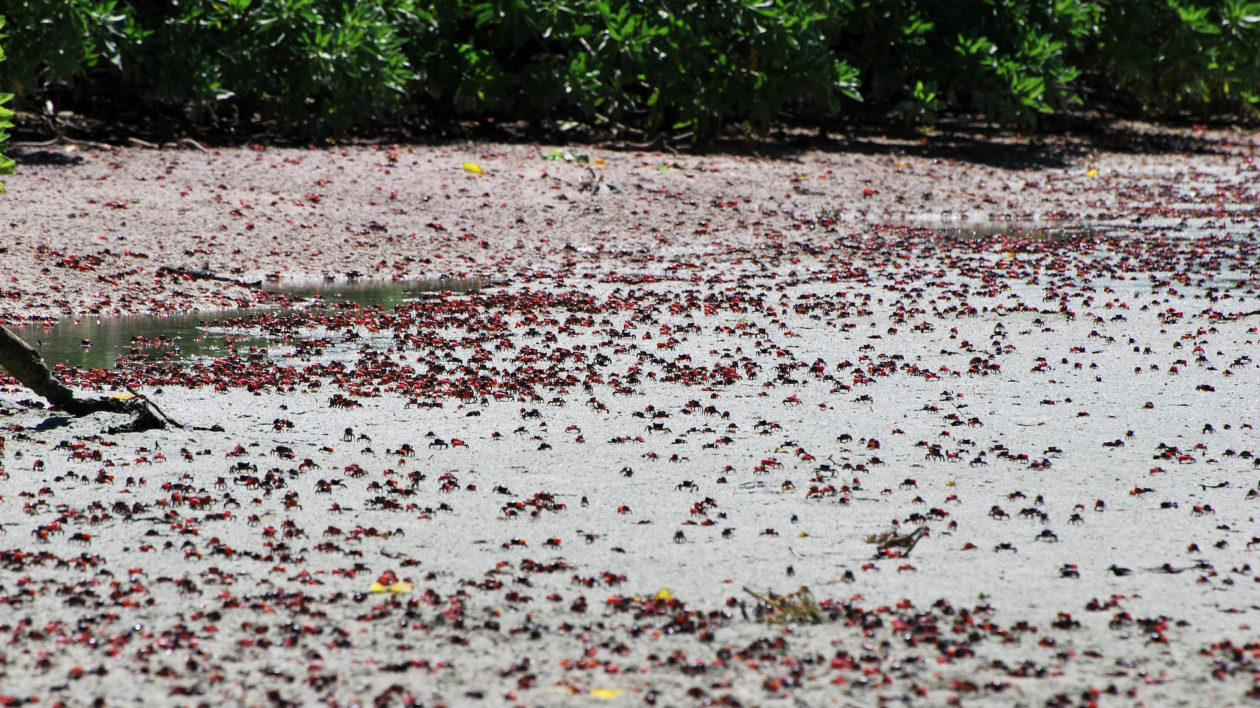
So I walk gingerly, shining my light on the path. Then I hear a much louder rustling. I swing my headlamp, and see a large form trundling through the leaf litter. This is no ordinary crab. It’s the one I’ve been looking for each evening: a coconut crab.
It’s a stunning creature, covered in blue-and-orange highlights, with an imposing claw waving in front. The crab is the size of a pie plate, and I know they can get much bigger.
The coconut crab is the largest land crab – and for that matter, the largest terrestrial arthropod – on the planet. In many parts of the world, it faces a perilous future. On Palmyra, though, the situation is much brighter.
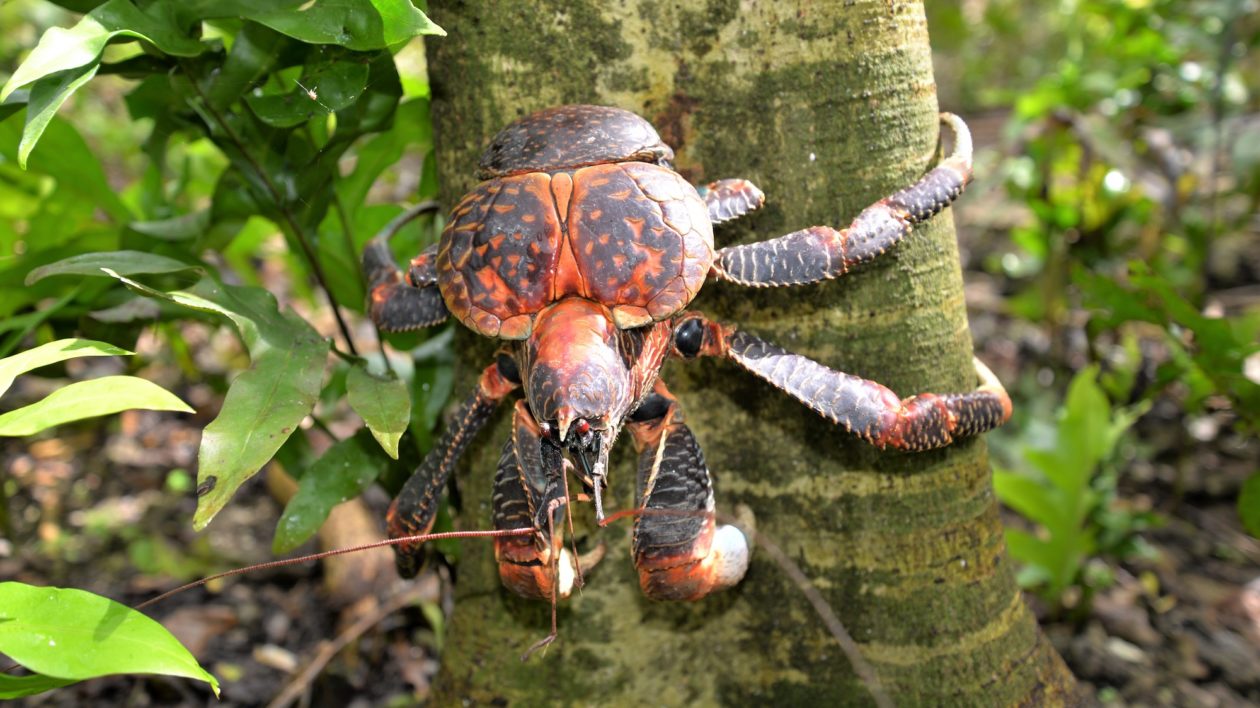
Life as a Coconut Crab
While a coconut crab will also skitter away when a human approaches, if you quietly move towards it, you can be rewarded with a lengthy observation. Up close, a coconut crab looks like a supersized version of a hermit crab, minus the shell.
That is actually the case: hermit crabs and coconut crabs are closely related. When coconut crabs are young, they live in shells in the same way as the hermit crabs you see in pet stores. As they get older, they abandon the shell and instead rely on their tough exterior for protection.
These are truly land crabs. The only time coconut crabs enter the water is when females release eggs into the ocean to start the larval process.
Unlike hermit crabs, they grow large. Very large. They can live for 60 years, with an adult measuring 3 feet across and weighing up to 9 pounds.
Then there’s that claw. Stories have long been told about the crab’s finger-crushing abilities. Recent research quantified that power. A crab can squeeze with a crushing force of 3000 newtons, or about 675 pound per square inch. Compare that to a lobster, which has a crushing force of 250 newtons.
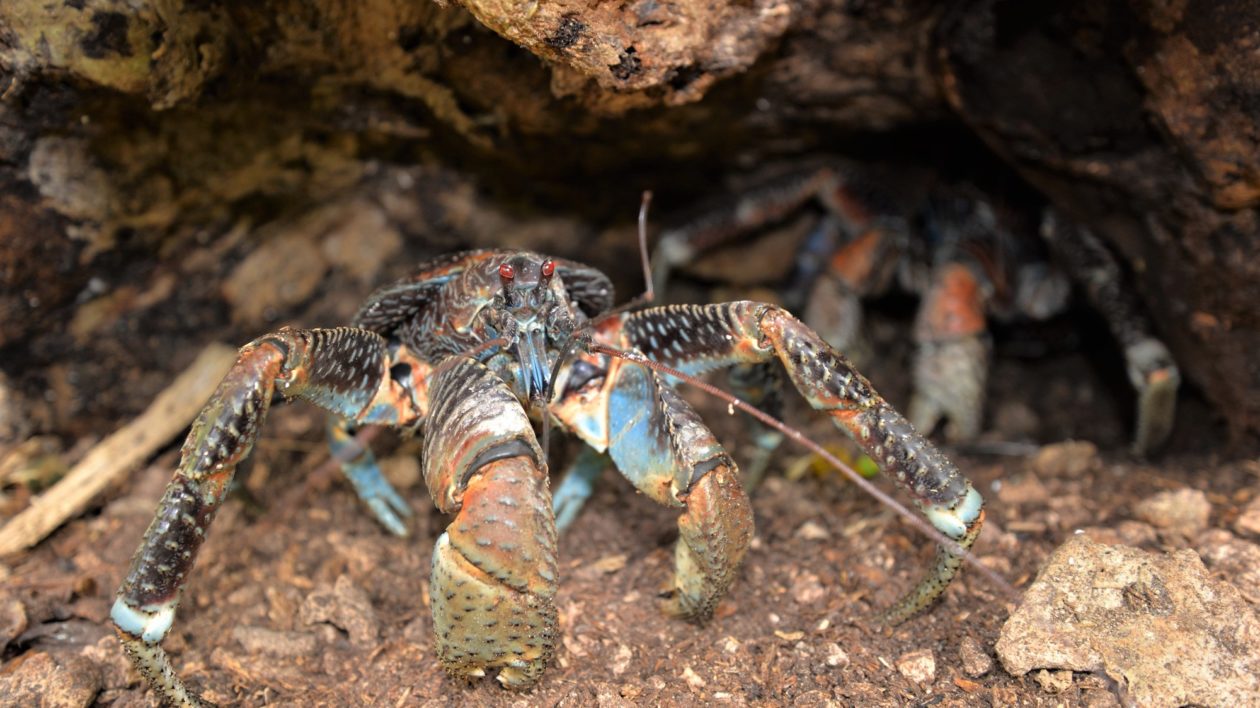
Coconut crabs can also lift more than 60 pounds, and yes, they can crush through coconuts. This has led to the idea that coconuts are the preferred food of this species, but that’s not really the case. Coconut crabs are scavengers and opportunists. They eat primarily fruits, nuts and the pith of fallen trees, but will also eat carrion. On Palmyra, they actively hunt prey, especially other crabs.
They’re also commonly known as robber crabs, partly for this tendency to eat just about anything and partly because they will also carry away items humans leave outside. Colorful stories abound, including one where a crab carried off a full whiskey bottle. Unlike, say, a pack rat, the coconut crab is not stealing shiny objects. Rather, it’s likely related to the crab’s excellent sense of smell. As the animals move around at night or dark rainforest, it relies on keen scenting abilities to find food. Human objects with a trace of food are thus carried off.
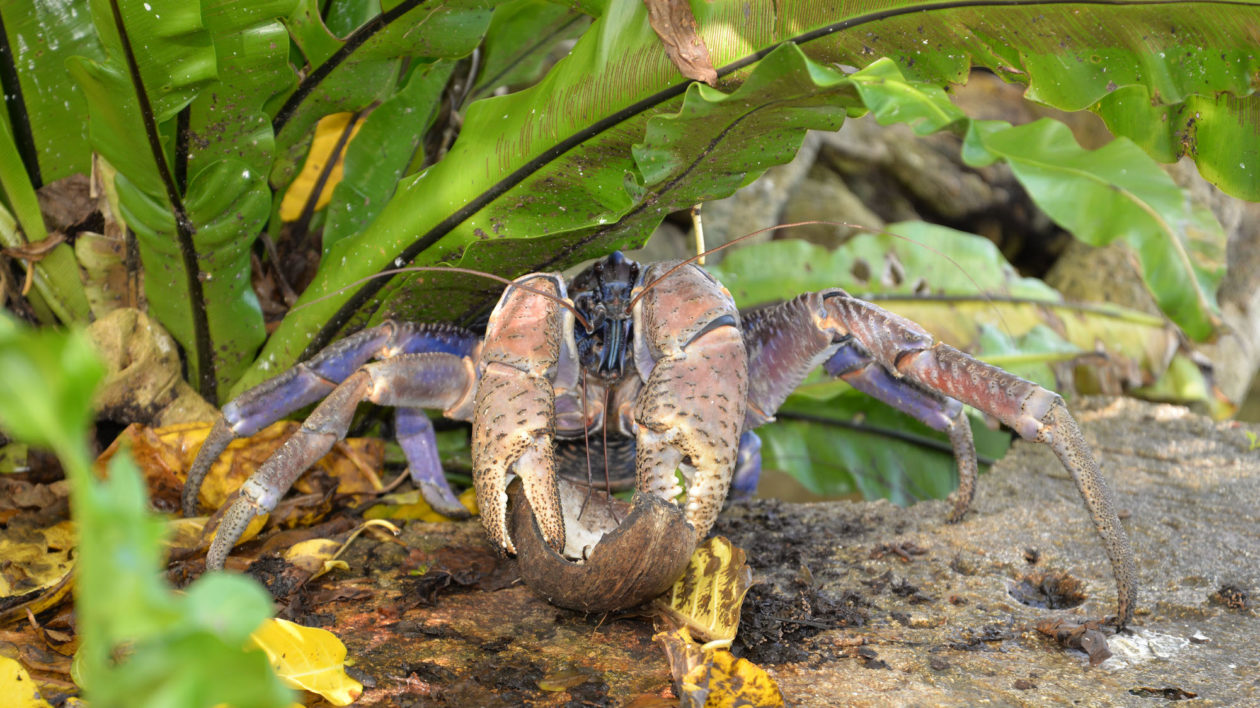
Coconut crabs are found widely in coastal habitats around the Pacific and Indian oceans. In many parts of their range, populations are declining. As reported this year in Mongabay, in some areas, coconut crabs have disappeared completely.
The crabs face a predictable litany of threats. Coconut crabs always live near the coast, often in forest habitats – areas that are often developed. Additionally, people eat coconut crabs so they are vulnerable to overharvesting. On many Pacific islands, they’re a difficult species to see.
That’s not the case on Palmyra. In fact, it’s easier to see coconut crabs than even a few years ago – thanks to a great conservation success.
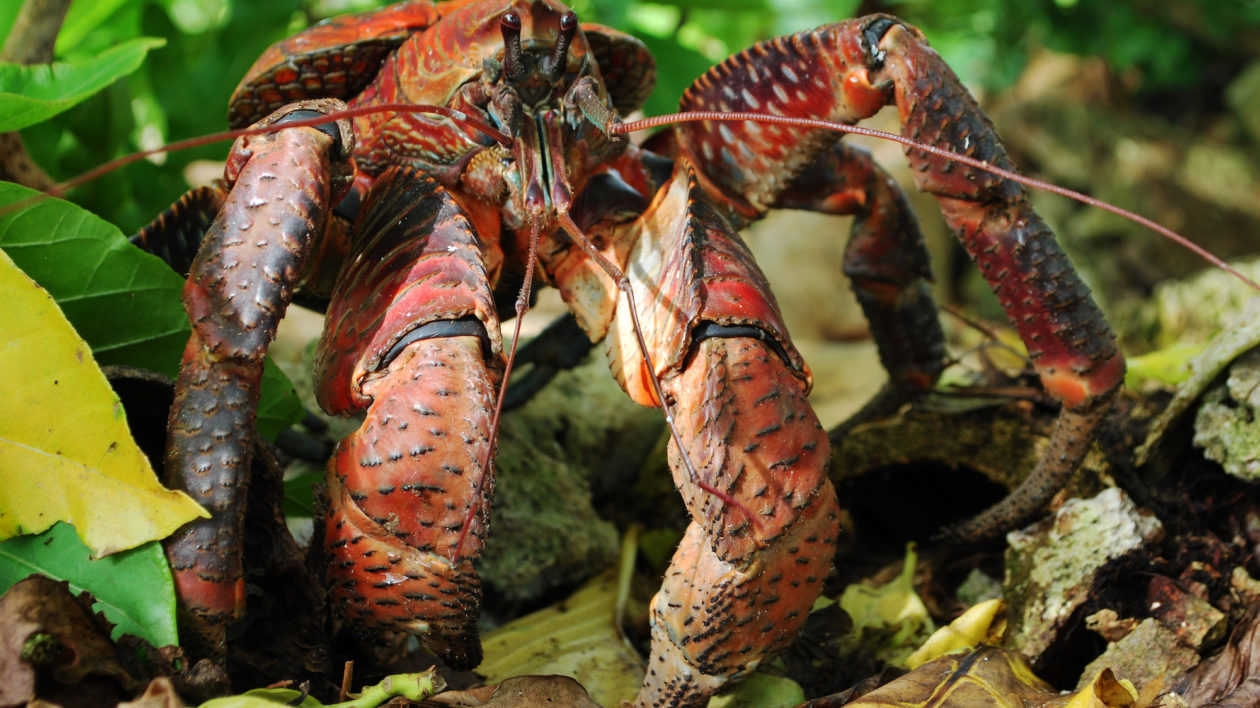
Of Crabs and Rats
Palmyra Atoll is a naturalist’s wonderland, with so many creatures to capture your attention. There are manta rays and gray reef sharks, sea turtles and huge colonies of birds. And fish of every conceivable size and color. With all these charismatic species around, it might seem hard for an invertebrate to win anyone’s heart.
But the crabs hold their own.
In part, it’s because they’re everywhere. There are the strawberry hermit crabs patrolling the beaches, and little fiddlers darting into burrows. There are crabs outside your cottage, around the docks, and in mind boggling numbers at the food refuse pit (any food waste is eaten within hours).
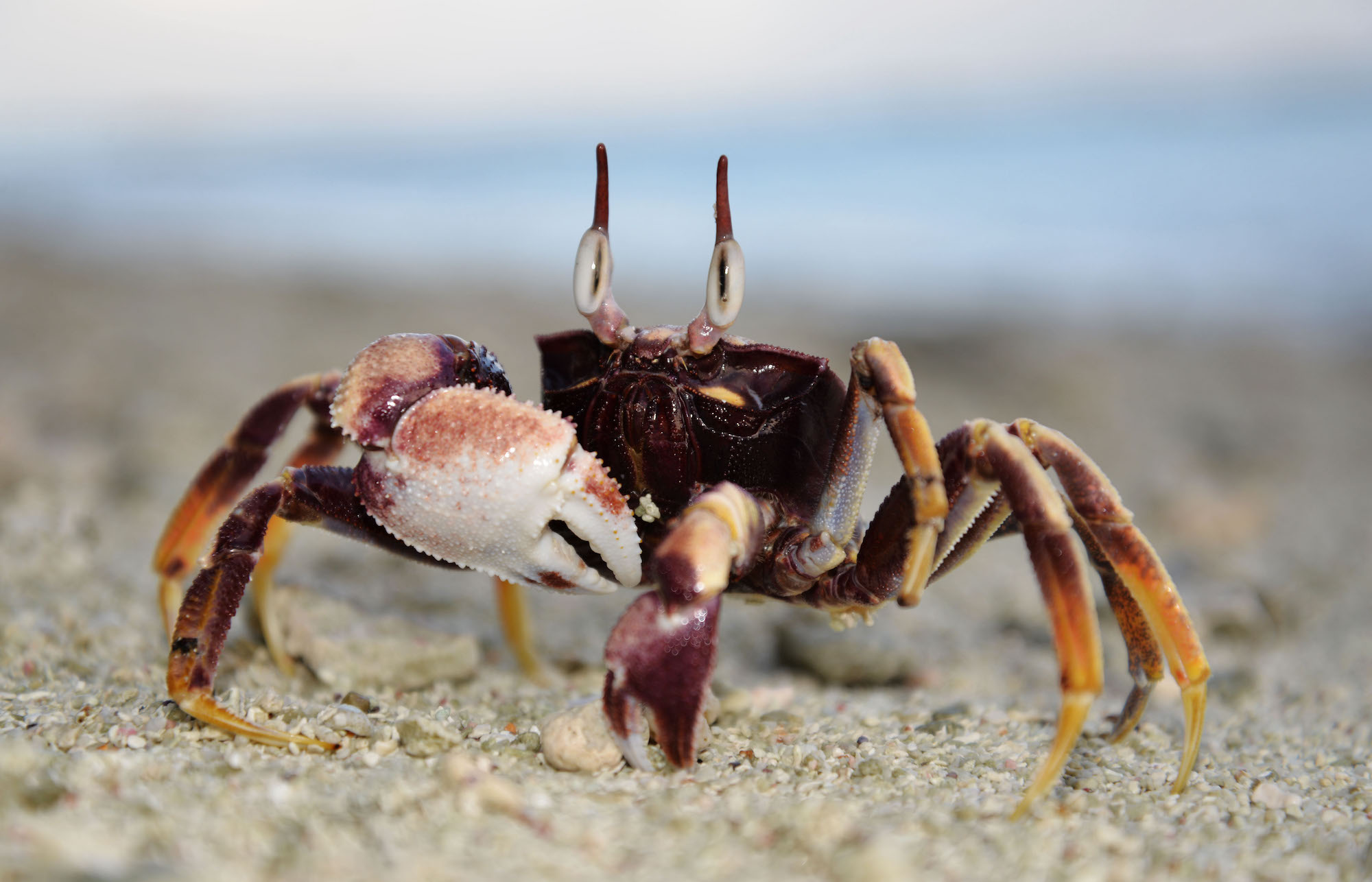
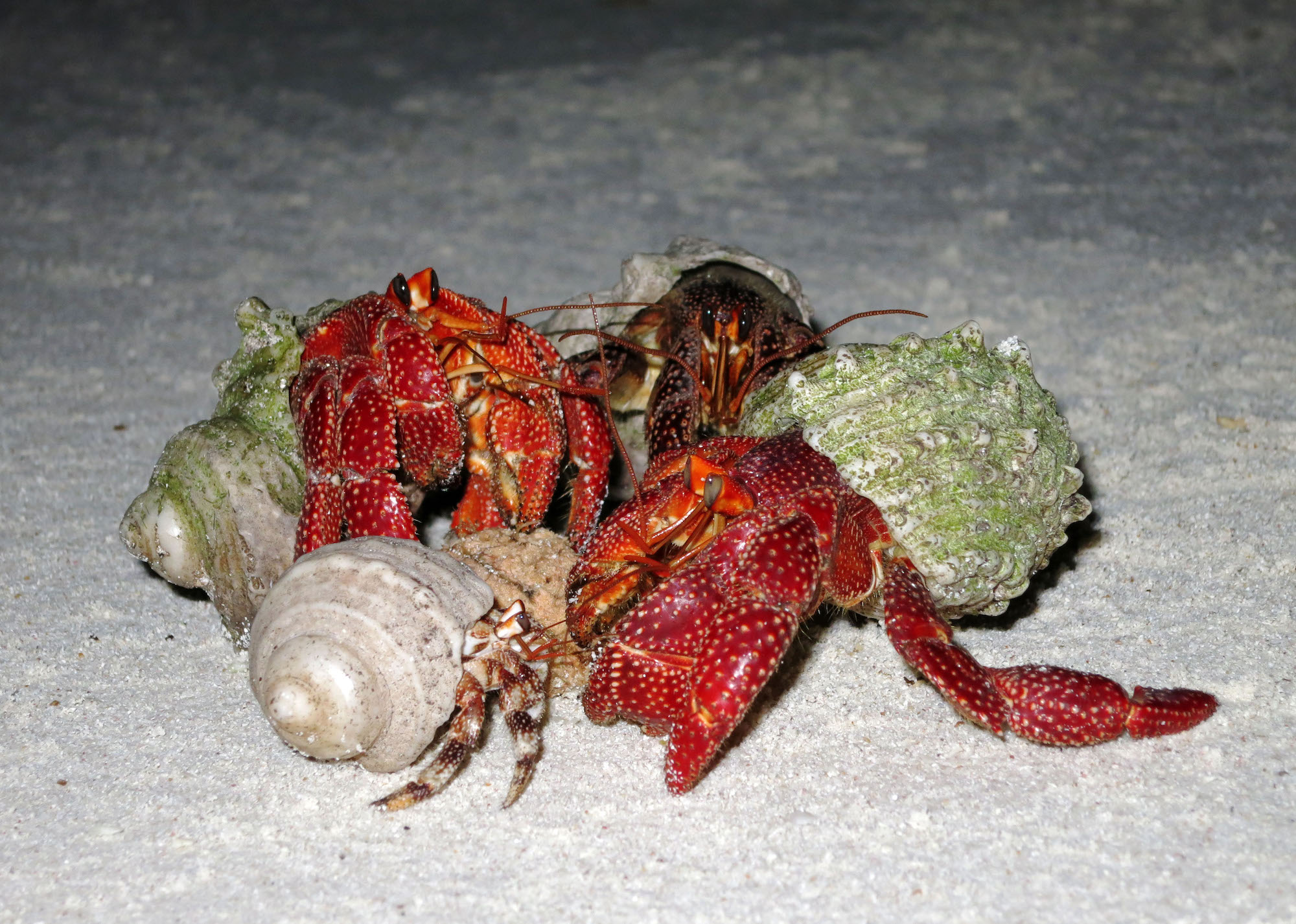
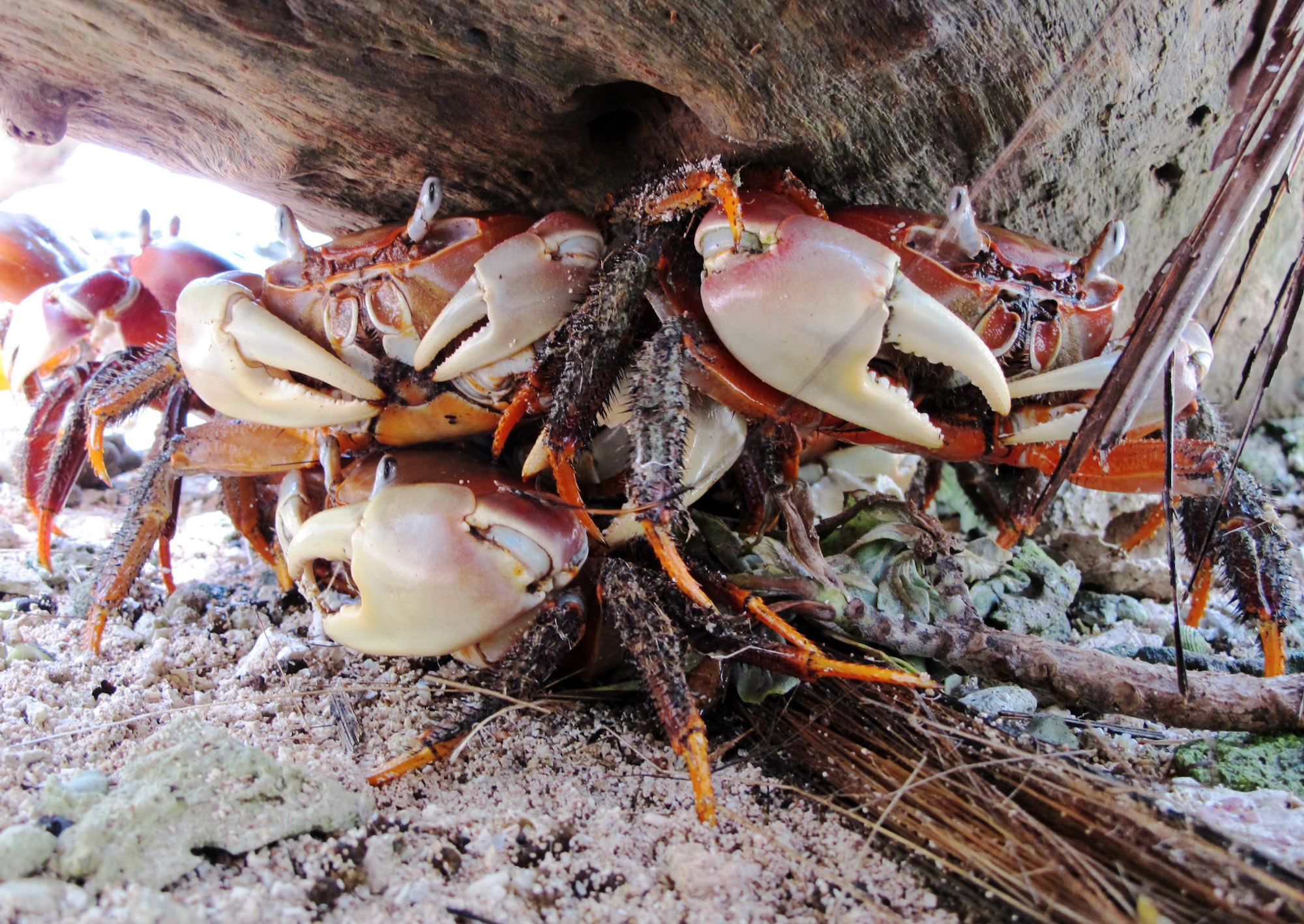
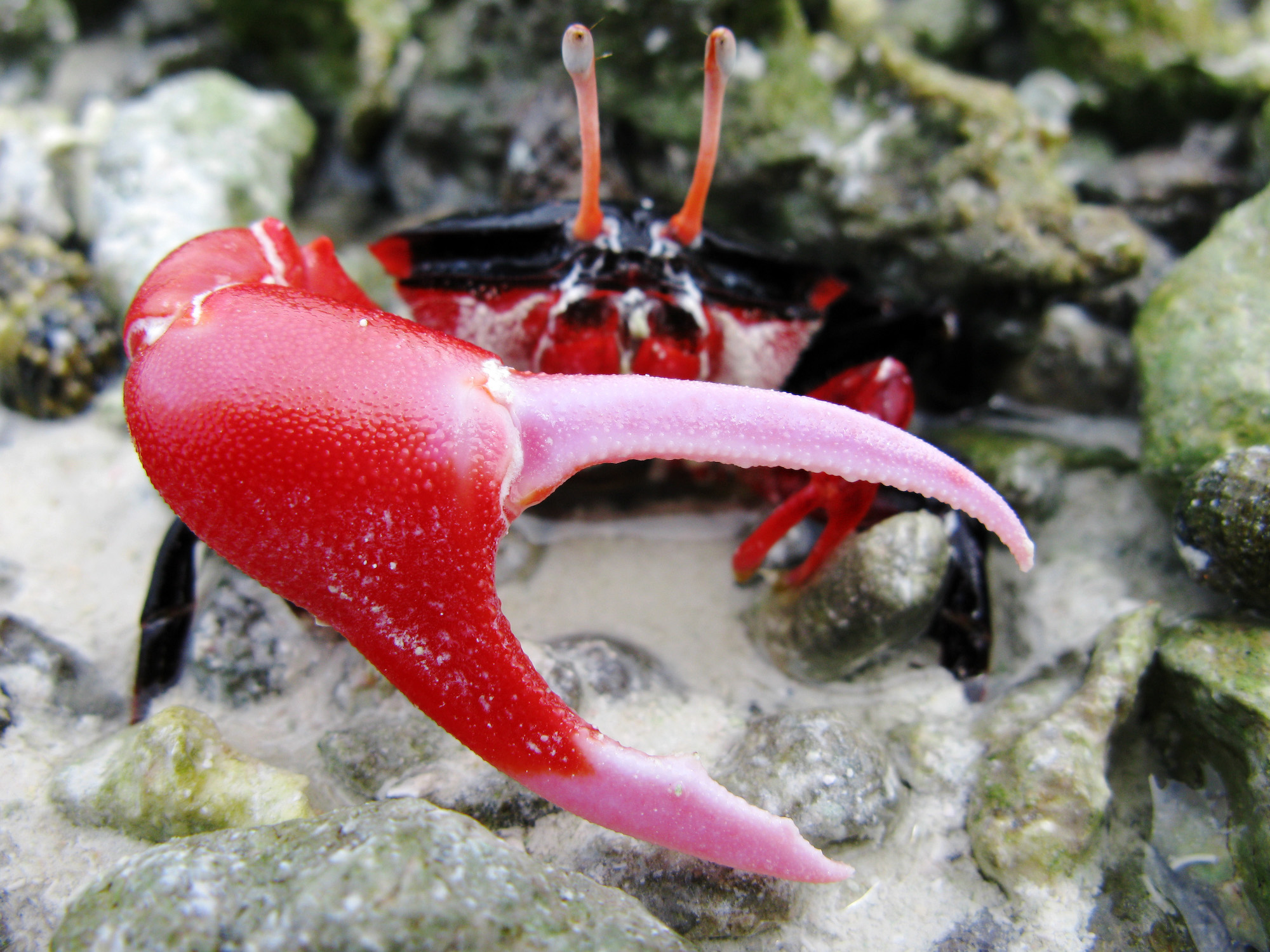
The coconut crab is the star, and a night-time crab walk will usually yield at least a few. U.S. Fish and Wildlife staff lead a weekly “crab walk” for visiting researchers and Palmyra’s seasonal staff. It’s a popular activity as the group attempts to see all 12 land crab species in an evening. Still, the coconut crab steals the show.
Seeing all these crabs, amidst this biological richness, it’s easy to call Palmyra Atoll a “pristine” environment. But that may be a bit misleading. Palmyra’s known history of human habitation is indeed fairly recent. Notably, it was a U.S. Naval base during World War II. The human presence now seems minimal, but that’s not the same as non-existent. People have caused significant impacts. Chief among those: rats.
Rats arrived, as they often do, on ships. They quickly began eating their way through Palmyra’s terrestrial biodiversity. Staff who worked on the island 10 or 20 years ago tell of the constant pitter-patter of rat feet through the trees and on roofs.

Rats are bad for island wildlife, a fact well established in too many islands around the globe. Many conservationists know they are hell on birds. They eat eggs and nestlings, devastating seabird colonies.
Less known is that invasive rats also devastate crab populations. Now, a coconut crab might seem a formidable foe for a rat, with its crushing claws and impressive strength. That’s true. Rats mainly don’t bother with adult crabs. They focus on the young crabs. With adult crabs living for decades, they persisted on Palmyra, but few young crabs survived.
In 2011, The Nature Conservancy, U.S. Fish and Wildlife Service and Island Conservation partnered to rid Palmyra of rats. It’s a success story environmental writer Ted Williams has called “the miracle on Palmyra.” The last science and technology allowed what had previously been thought an impossible dream: to eradicate every last rat on the island.
It worked. In 2015, Palmyra was proclaimed “rat free.”
Since then, several land crab populations have increased 450 percent. There are two species of tree crabs that researchers didn’t even know existed on Palmyra. They were first documented two years after rat eradication; now they are everywhere.
Coconut crab young are surviving. I often found coconut crabs scuttling away just a short distance from the research base.
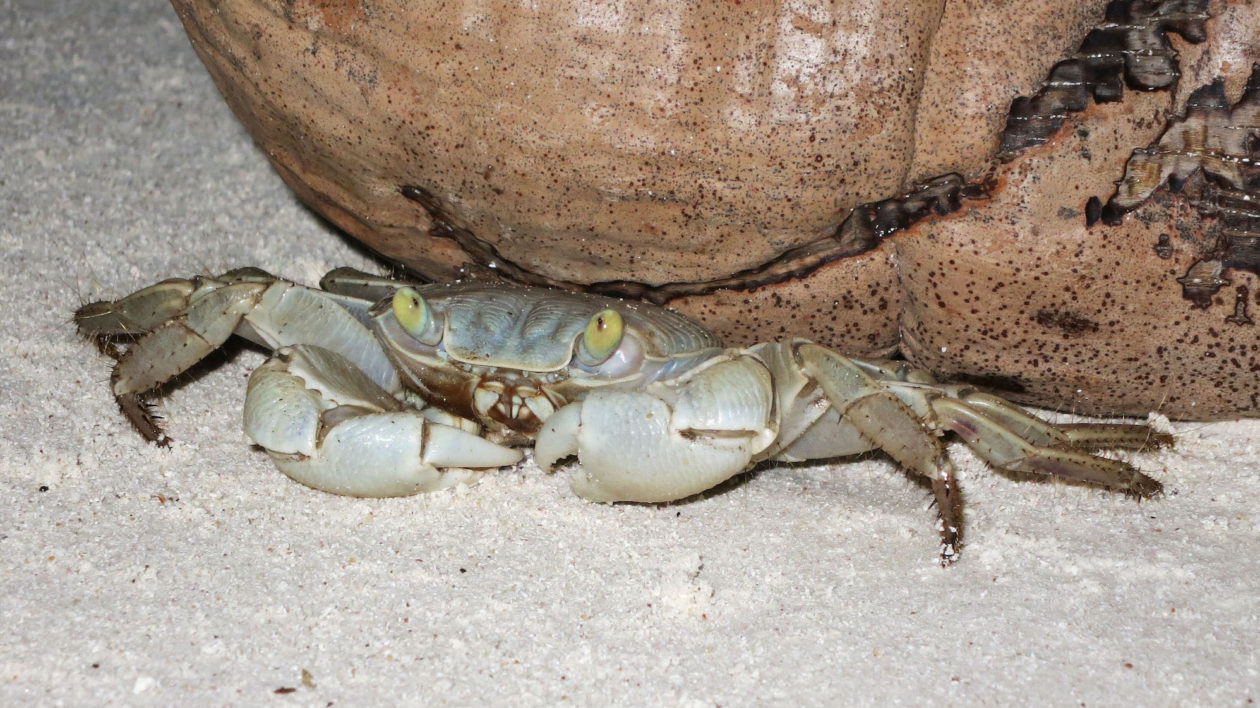
Pristine Islands and the Future of Crabs
On my last morning on Palmyra, research tasks completed, I was invited to join a tour to Sand Island, one of many small islands that make up Palmyra. Sand Island has the distinction of being free of invasive species, or at least as free of them as is possible in today’s world.
Before we left, we had to be clean. Biosecurity protocols are taken very seriously on the whole of Palmyra. Before I visited, I had to attend numerous briefings to ensure I would not bring any new invasive species, large or small. Luggage and all luggage contents had to be frozen prior to departure. New clothing and gear was preferred.
For Sand Island, even that was not deemed sufficient. We had to wear clothing and shoes that had been carefully disinfected by U.S. Fish and Wildlife Service staff, and that never left the island. Donning our outfits we boarded small boats and headed to Sand Island.

For many, the idea of a tropical island paradise might be endless white sand. For me, it’s Sand Island. Despite the name, the beach isn’t large and much of the island is forested. But the sounds of birds, the nesting fairy terns and boobies gazing down on you from feet away, the sea turtles gliding by…all you can do is smile and take it all in.
Once again, despite all this, the coconut crabs steal the show. The native, intact Pisonia rainforest provides ideal habitat for the crabs. It provides cover and prevents them from becoming dessicated in the sun. Here crabs roam around during daylight hours. (In most areas, they’re strictly nocturnal and cover themselves in sand or leaves during the day).
These are the biggest coconut crabs of the trip, behemoths hiding under upturned stumps and strolling around the forest.
One crab, named “George” by a visiting nature documentary crew, emerged as if on cue. He’s been living in the same spot for years. It’s hard not to ascribe human characteristics to George, seeming to rule this section of island. But George is awesome in his own right, a crab going about his life as crabs once did everywhere.
Amid recent bad news about coconut crabs, it’s important to have such refuges. A place where coconut crabs can thrive – with a little help from humans.
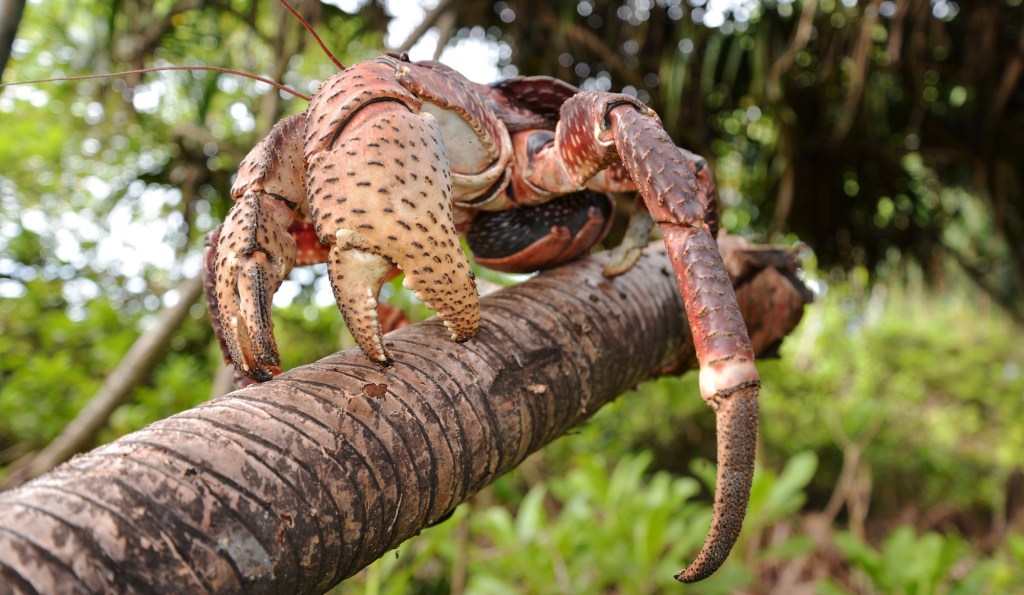



I heard they will eat you if you fall asleep on the beach. Or at least try. True?
Hi Phoebe,
Thanks for your question. You would not have to fear a coconut crab eating you if you fell asleep on the beach. Coconut crabs will scavenge. They have also reportedly caught and eaten birds. But a live human? No. In most places, humans hunt coconut crabs so the crabs are extremely wary and will quickly scurry away from humans. That said, they can deliver a very nasty pinch to a human who tries to handle or catch them. But that’s a defensive strategy…they aren’t trying to eat the human.
Best,
Matt Miller
Excellent Article!
So glad to have discovered Mr. Miller and this blog.
Fantastic … I had read about the rat purge from Palmyra but had never read about Sand Island that had to be a fantastic experience.